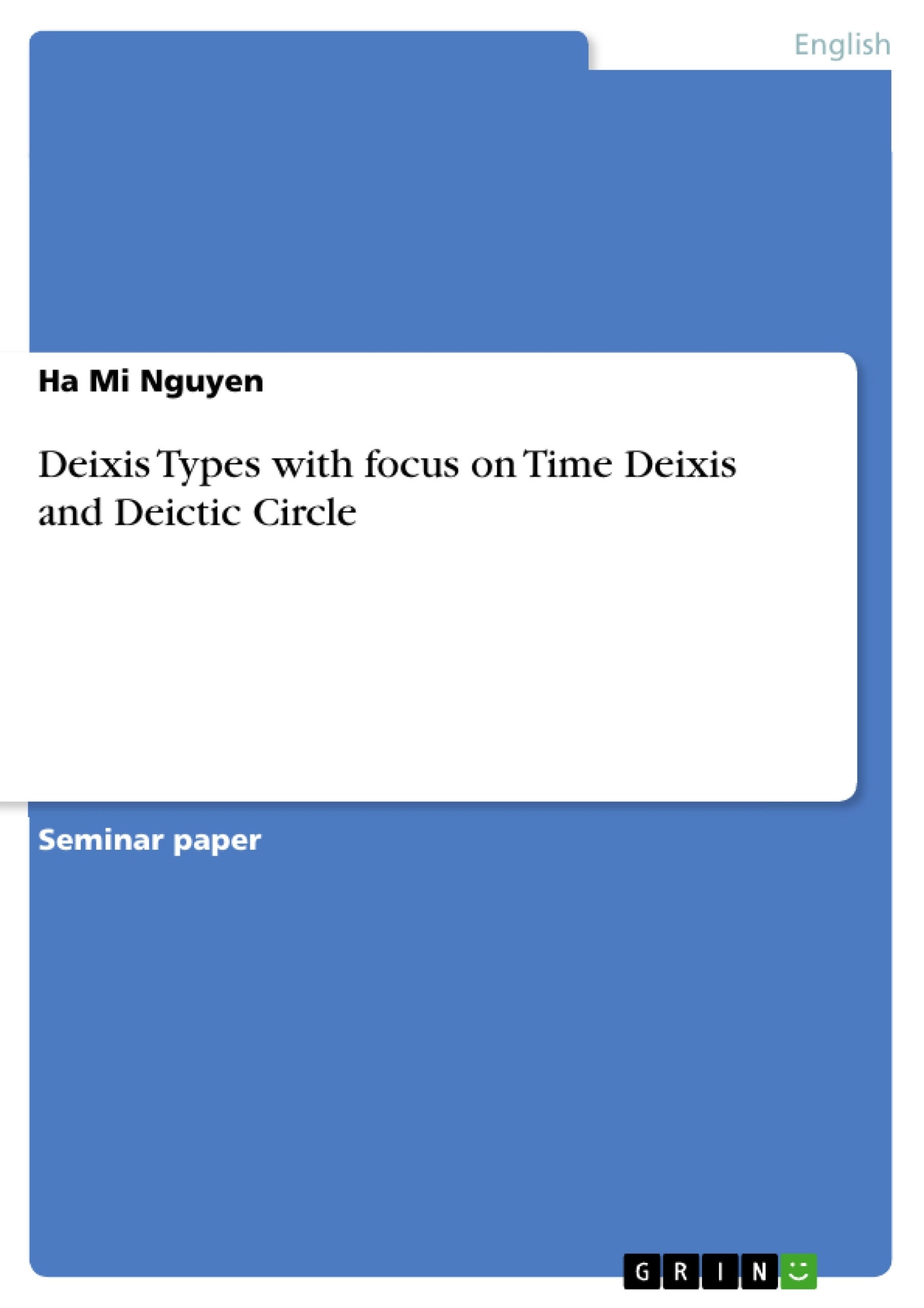In this term paper I will introduce you into the topic “deixis” in the English language, where I will especially focus on one of the main types of deixis: time deixis. First of all, I am going to give a short definition of deixis in general. After that I will mention the types of deixis and give some information about each of them. Moreover, I will explain time deixis in detail and I will also talk about the deictic circle in relation to shifting from the direct into indirect speech with special focus on time deixis.
Table of Contents
- 1. Introduction
- 1.1 Definition: Deixis
- 1.2 Types of deixis
- 2. Time Deixis
- 3. Deictic Circle
- 3.1 Converting direct into indirect speech
- 3.2 Definition: Deictic Circle
- 4. Conclusion
Objectives and Key Themes
This term paper aims to introduce the concept of deixis in the English language, with a particular focus on time deixis. It explores the definition of deixis, its various types, and the implications of shifting from direct to indirect speech, specifically concerning temporal expressions.
- Definition and types of deixis
- Detailed explanation of time deixis
- The impact of direct-to-indirect speech conversion on time deixis
- The deictic circle and its role in understanding temporal shifts
- Analysis of deictic expressions in English
Chapter Summaries
1. Introduction: This introductory chapter provides a concise definition of deixis, explaining its origins in the Greek word "deiknunai" meaning "to show" or "to point." It emphasizes that while all languages utilize deixis, there's no universality in deictic expressions. The chapter highlights the function and use of deictic words, noting their context-dependent meaning and the frequent use of gestures. It introduces the three main types of deixis: person, place, and time, laying the groundwork for a deeper exploration of time deixis in subsequent sections. The chapter also briefly mentions the less common discourse and social deixis types.
2. Time Deixis: This chapter delves into the specifics of time deixis, defining it as an expression relating to a point in time when an utterance is produced. It differentiates between coding time (utterance time) and receiving time (interpretation time), particularly relevant in written or recorded communication. The chapter emphasizes "now" as the deictic center for time deixis, explaining how temporal expressions are counted backward or forward from this point. The crucial role of tense in encoding both deictic and aspectual distinctions is discussed, highlighting the importance of understanding the relationship between utterance time and event time to interpret temporal references accurately. The use of time adverbs is also examined.
Keywords
Deixis, Time Deixis, Person Deixis, Place Deixis, Deictic Circle, Direct Speech, Indirect Speech, Tense, Coding Time, Receiving Time, English Language, Deictic Expressions.
Frequently Asked Questions: A Comprehensive Language Preview on Deixis
What is the main topic of this language preview?
This preview focuses on deixis in the English language, with a particular emphasis on time deixis. It explores the definition, types, and implications of deixis, especially concerning the shift from direct to indirect speech.
What are the key themes covered in this preview?
The key themes include the definition and types of deixis (person, place, time, and briefly, discourse and social deixis), a detailed explanation of time deixis, the impact of direct-to-indirect speech conversion on time deixis, the deictic circle and its role in understanding temporal shifts, and an analysis of deictic expressions in English.
What is deixis, and what are its different types?
Deixis, originating from the Greek word "deiknunai" meaning "to show" or "to point," refers to words whose meaning depends on the context of their utterance. The preview primarily covers person, place, and time deixis. Person deixis refers to the speaker, addressee, and other participants. Place deixis concerns location. Time deixis, the main focus, relates to points in time.
What is the significance of time deixis?
Time deixis is crucial because its meaning is tied to the moment of utterance (coding time) and the moment of interpretation (receiving time). The concept of "now" serves as the deictic center, with temporal expressions relating to this point. The preview examines how tense contributes to both deictic and aspectual distinctions, emphasizing the relationship between utterance time and event time in interpreting temporal references.
How does the conversion from direct to indirect speech affect time deixis?
The shift from direct to indirect speech significantly impacts time deixis. The preview highlights this transformation and how temporal expressions change when moving between direct and indirect quotes. Understanding the deictic circle is vital for analyzing these shifts.
What is the deictic circle, and what is its role in understanding temporal shifts?
The deictic circle is a conceptual framework that helps understand how deictic expressions change their reference depending on the context. This is particularly relevant when converting direct speech to indirect speech, as the deictic center shifts. The preview defines the deictic circle and explains its significance in resolving changes in temporal references.
What are the chapter summaries included in this preview?
The preview offers summaries of an introductory chapter defining deixis and its types, a chapter dedicated to time deixis, explaining its intricacies and the role of tense, and a concluding chapter. Each summary gives a brief overview of the chapter's content and main arguments.
What are the keywords associated with this language preview?
The keywords include Deixis, Time Deixis, Person Deixis, Place Deixis, Deictic Circle, Direct Speech, Indirect Speech, Tense, Coding Time, Receiving Time, English Language, and Deictic Expressions.
What is the overall objective of this language preview?
The preview aims to provide a comprehensive introduction to deixis, focusing on time deixis and its implications in direct and indirect speech. It seeks to clarify the core concepts and their interconnectedness.
- Quote paper
- Ha Mi Nguyen (Author), 2017, Deixis Types with focus on Time Deixis and Deictic Circle, Munich, GRIN Verlag, https://www.grin.com/document/436399



